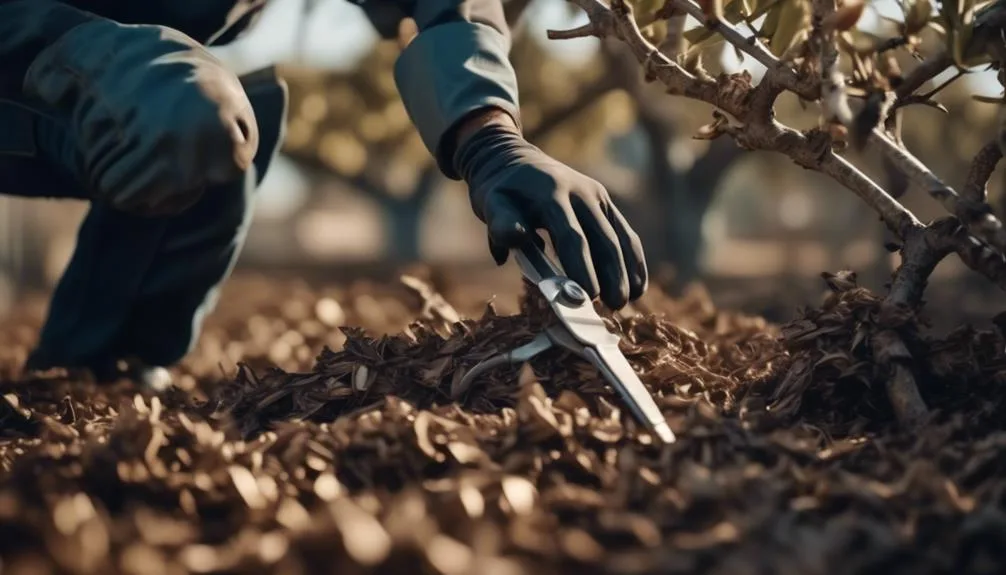With autumn here, it's important to get your almond trees ready for winter. Preparing them properly is crucial for their health and productivity. This involves pruning, protecting from pests, and providing nutrients.
How do you make sure your almond trees can handle the cold and come back strong in the spring? Let's look at the essential steps to get your almond trees through the winter months.
Key Takeaways
- Prune almond trees in winter to remove dead, damaged, or diseased branches and shape the tree for strong branch structure.
- Protect almond trees from cold by adding mulch for soil insulation, covering them with frost cloth or blankets, and erecting windbreaks.
- Provide adequate water and nutrients to almond trees by conducting a soil test, adjusting fertilizer application, and ensuring proper irrigation.
- Manage pests and diseases by monitoring trees regularly, implementing good cultural practices, and maintaining a clean orchard floor.
Pruning Almond Trees
To ensure healthy growth and abundant harvest, you should commence pruning your almond trees as the winter season approaches. Proper pruning techniques are essential for maintaining the health and productivity of your almond trees.
Start by removing any dead, damaged, or diseased branches to prevent the spread of infection. Additionally, thin out the tree to allow for better air circulation and sunlight penetration, promoting overall tree health.
Winter care also involves shaping the tree to encourage strong branch structure and facilitate easier harvesting. Be sure to sterilize your pruning tools between cuts to prevent the transmission of diseases.
Protecting Almond Trees From Cold
As you prepare your almond trees for the winter season, it's crucial to take steps to protect them from the cold to ensure their health and productivity. Here are three essential measures to safeguard your almond trees from the chilling effects of winter:
- Soil Insulation: Add a thick layer of mulch around the base of the trees to help insulate the soil and regulate its temperature. This will prevent rapid freezing and thawing which can be damaging to the roots.
- Frost Prevention: Cover your almond trees with frost cloth or blankets during cold nights to shield them from frost. This simple step can make a significant difference in protecting tender buds and new growth.
- Windbreaks: Erect temporary windbreaks around the trees to reduce the impact of cold winds. This can help maintain a more stable microclimate, shielding the trees from harsh winter conditions.
Providing Adequate Water and Nutrients
Maintain the health and vigor of your almond trees through proper irrigation and balanced nutrient application throughout the winter months.
Start by conducting a soil test to determine the specific nutrient needs of your almond trees.
Based on the results, adjust the fertilizer application to ensure that the trees receive adequate nutrients to support their health during the winter. Consider using a slow-release fertilizer to provide a steady supply of nutrients over an extended period.
Additionally, ensure that the almond trees receive sufficient water, especially during dry periods. Proper irrigation is crucial for the trees to withstand the winter and emerge healthy in the spring.
Pest and Disease Management
Ensuring proper irrigation and nutrient balance not only promotes the health of your almond trees but also plays a crucial role in managing pests and diseases. Integrated pest and disease management is essential for maintaining the well-being of your almond trees.
Here are three key strategies to effectively manage pests and diseases:
- Regular Monitoring: Keep a close eye on your almond trees for any signs of pest infestation or disease development. Early detection allows for timely intervention, preventing further spread and damage.
- Cultural Practices: Implement good cultural practices such as proper pruning, adequate spacing between trees, and maintaining a clean orchard floor to reduce the likelihood of pest and disease outbreaks.
- Biological Controls: Introduce beneficial insects or organisms that naturally control pest populations, reducing the need for chemical interventions.
Wrapping Almond Trees for Winter
Prepare your almond trees for winter by wrapping the trunks with protective materials to shield them from harsh weather conditions. When it comes to wrapping techniques, start by using burlap or commercial tree wrap.
Begin at the base of the tree and wrap the material around the trunk in an upward spiral, overlapping each layer slightly to ensure complete coverage. Secure the wrapping with twine or tape, but be sure not to wrap it too tightly to allow for some expansion.
This insulation will protect the tender bark from harsh winter winds and fluctuations in temperature. Additionally, consider using insulation materials such as foam tubing for added protection, especially for younger trees.
Conclusion
In preparing your almond trees for winter, you've taken crucial steps to ensure their health and strength during the colder months.
By pruning, protecting from cold, providing water and nutrients, managing pests and diseases, and wrapping them up, you've set your trees up for success.
With these measures in place, you've positioned your almond trees to thrive and yield a bountiful harvest come springtime.
Now, as winter approaches, you can rest assured that your efforts will pay off, and your almond trees will be ready to flourish when the warmer weather returns.

